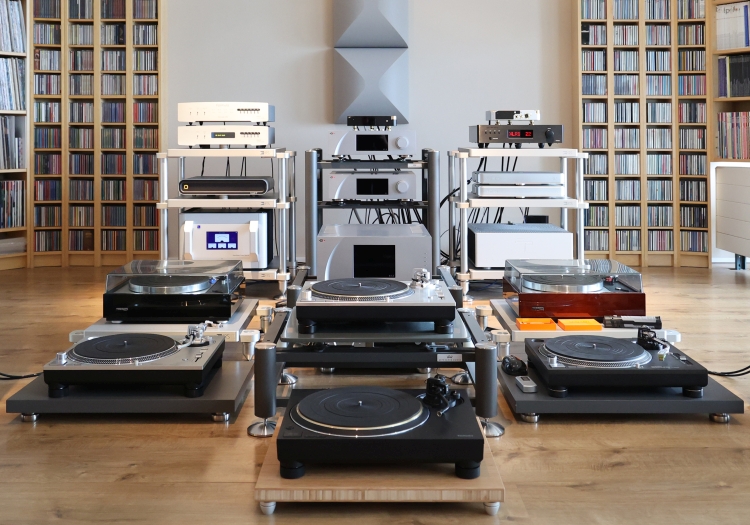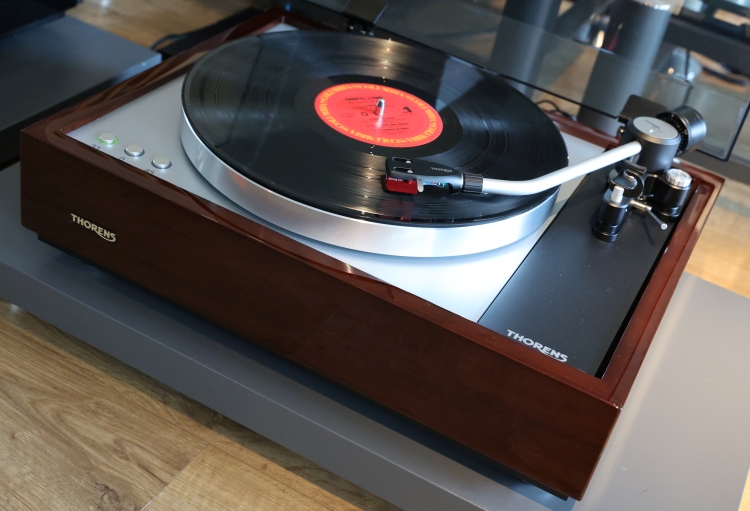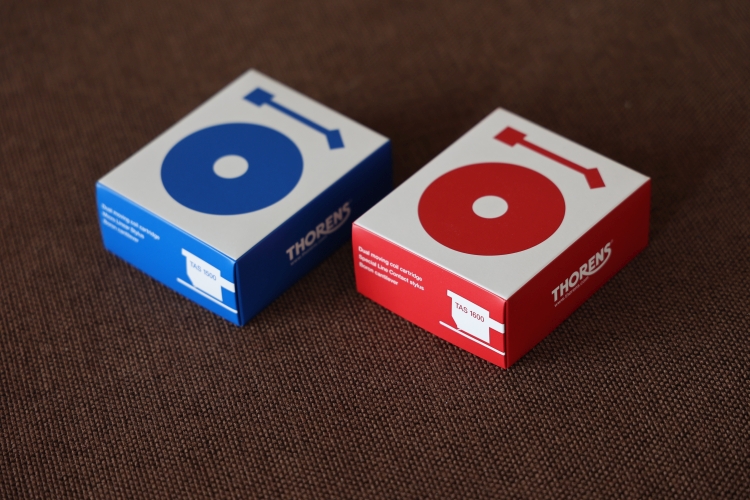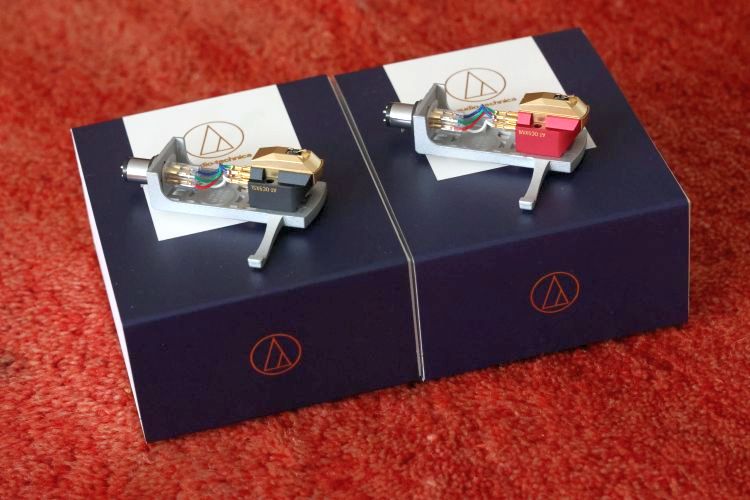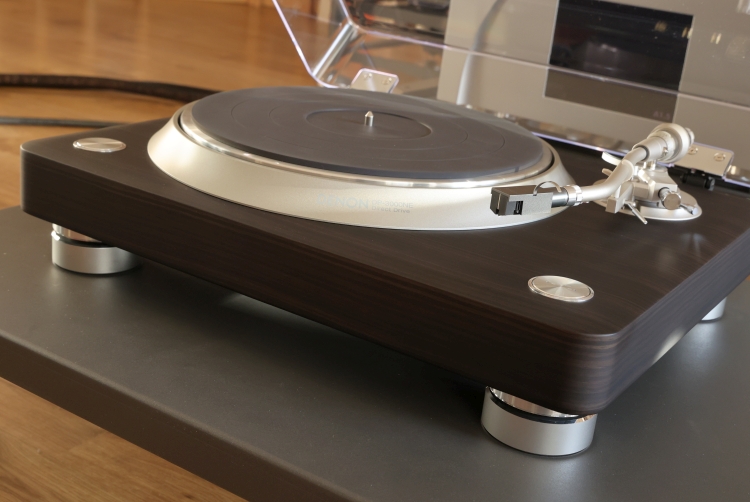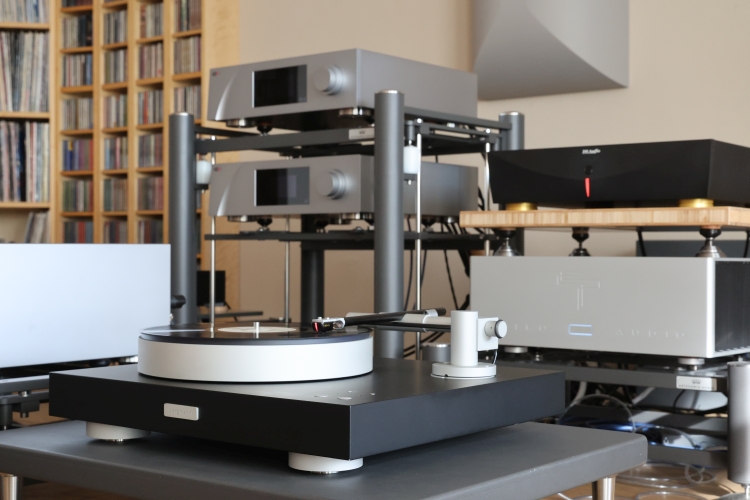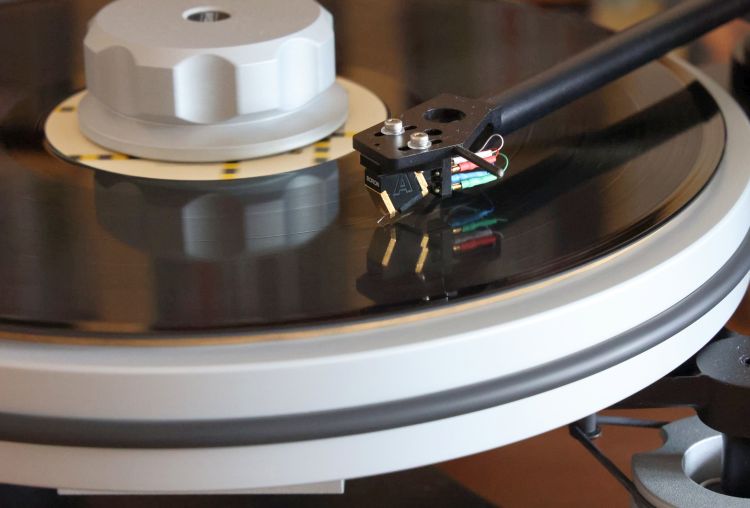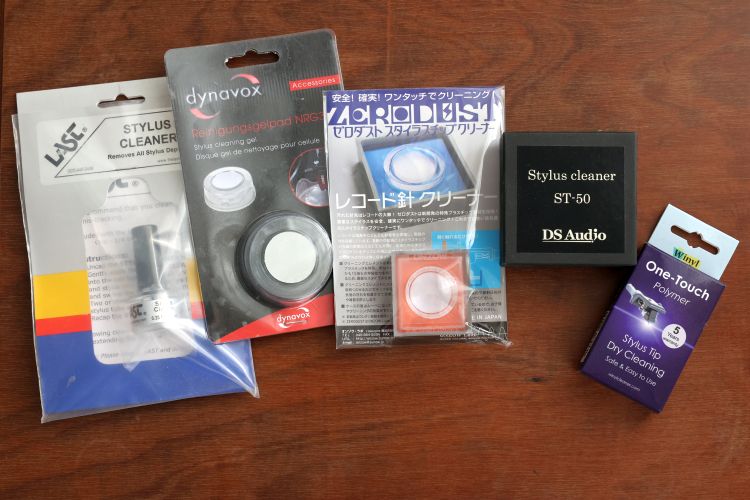Holbo Airbearing Turntable and Acoustical Systems Aiwon and Palladian MC cartridges
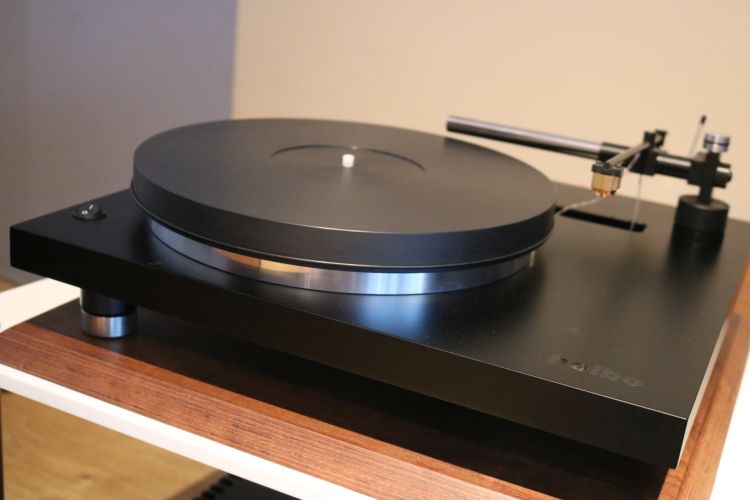
Review samples supplied by Colab
Retail prices in the Benelux (including 21% VAT): 6.500 euro
Holbo Airbearing Turntable:
Acoustical Systems Aiwon: 6.980 euro
Acoustical Systems Palladian: 8.980 euro
Technical Matters
High-end turntables tend to be bulky, large, heavy and complex but the Holbo is none of these. With this turntable, there is no separate motor, no ridiculously bulky platter and no bridge-size arm carriage. In all honesty, the Holbo looks conspicuously simple and I must admit to having underestimated it.
Especially when it comes to linear tracking turntables and air bearings, one may think this will involve lots of care and results in an ongoing tweaky operation. But the Holbo air-bearing turntable aims to completely turn that notion upside down. This turntable is incredibly simple to operate and when adjusted properly is pretty much a set-and-forget solution. All of its parameters have been carefully considered to achieve the best possible sound as well as the most trouble-free operation. It is the perfected result of a long study into perfecting the ideal turntable, culminating in this one-stop solution and that is why there is only one model in the Holbo catalog.
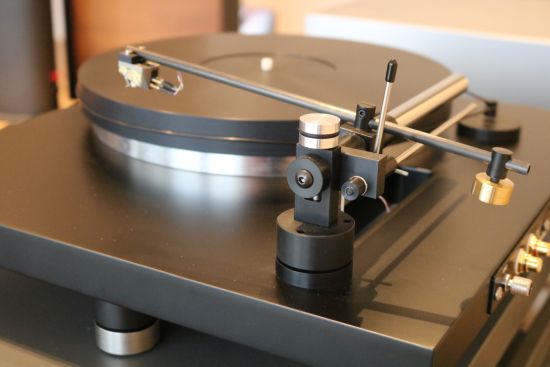
While visually understated, a close inspection reveals that the Holbo turntable contains many clever ideas that make adjusting and operating it a breeze. The arm can be adjusted in all directions but once adjusted (by your dealer, if you like), it is fixed in position very rigidly. There are two external boxes, the power supply and the air pump. The former can just be connected and never needs a second thought after that because switching on the platter rotation is done from the turntable itself. The air pump is not 100% inaudible but it is so silent that it can be positioned behind the system without being audible. You can hear a soft whirr when up close but you can’t hear this from the listening position. My refrigerator, for example, is way louder. If desired the pump can be fitted with a dehumidifier but as was explained to me, that really is not necessary unless one consistently forgets to switch off the pump at the end of the listening sessions.
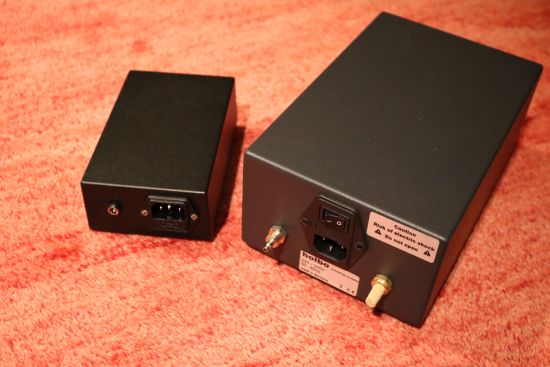
The air pump provides pressurized air for the platter as well as the arm. The funny thing is that when the air pump is off, the platter rests directly on the metal layer underneath and it cannot be rotated until the air pressure is on. Then, all of a sudden, it rotates entirely freely. It’s easy to understand how this works but it still is fascinating to see it in practice. The platter is rotated via a precision-cast (not glued) rubber belt that is driven by an electronically-controlled DC-motor. This motor seems to be coupled rigidly to the turntable chassis but thanks to the air bearing, this has absolutely no audible influences. The tangential arm is attached to a collar that moves over a polished steel tube. Rather than this tube being perforated for creating the air cushion (and losing a lot of pressure via the exposed holes), the arm collar itself is attached to the air pump via an extremely thin and very flexible tube, making it move silently, efficiently and without any friction. In fact, the arm’s motion is so very smooth that you can witness it moving left and right by more than a millimeter when playing a record that was cut off-center. With regular pivot arms, this would result in speed variations as the arm gets shorter and longer but with the Holbo’s tangential arm, that just does not happen. Reassuringly, you can even see that the cantilever is entirely static while the entire arm assembly is being moved left and right by the grooves in the record. That’s how little friction the arm has!
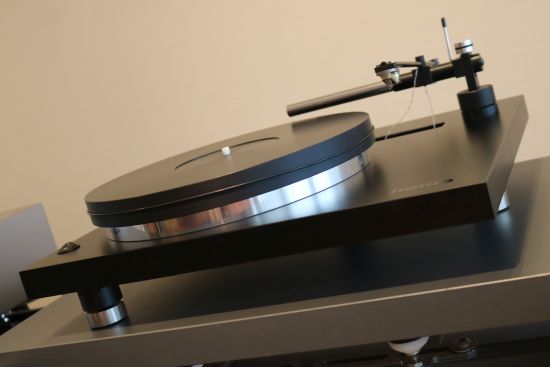
The cabling to the arm has been cleverly routed through a slit in the turntable’s body. This way, there is no getting stuck in any protruding wires while it makes for a very tidy look.
When the turntable was delivered to me it was fitted with an Acoustical Systems Aiwon MC cartridge. Quoted as having high-Purity 5N Silver Coils, a special dampened timet 1100 titanium alloy corpus, 0.33 mV output, a Q4 Shibata EVO stylus and a C37-coated tempered aluminum Cantilever, this is no ordinary cartridge and it is priced accordingly. Delivered along with the Aiwon was Acoustical Systems’ latest novelty the Palladian MC cartridge that is even more special but I’ll get to that further down. For now, my listening starts with the Aiwon.
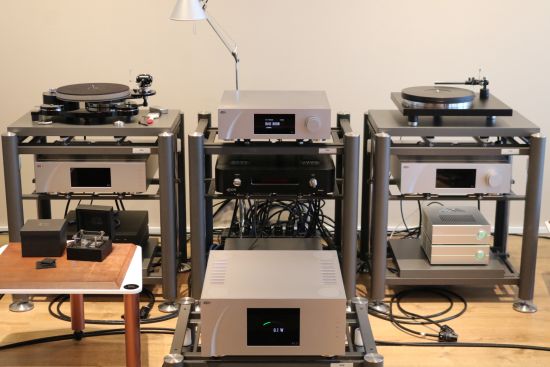
System context
The Holbo was listened to using a range of phono preamps such as the Lejonklou Entity, the Line Magnetic LP-33 and the Jeff Rowland Cadence with BPS-2 power supply. With a regular power supply, the latter is a little too sweet and relaxed for my current taste but with the BPS-2 and associated huge switching power supply, the Cadence was actually not that far removed from the epic performance of the CH Precision P1. My reference, however, remains the P1 and so this is what I used predominantly.
The rest of the system consists of the Ayon Stealth tube preamp, the CH Precision A1.5 power amp and the Martin Logan ESL15A loudspeakers.
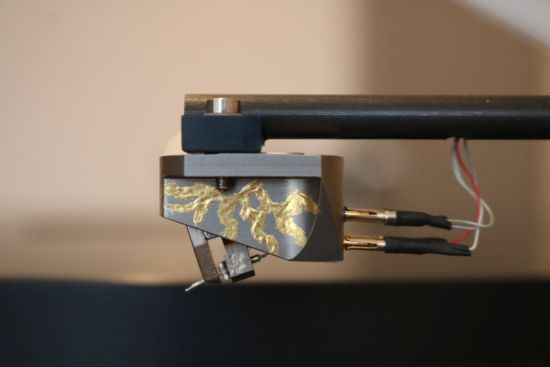
Listening with the Aiwon
Fitted with the Acoustical Systems Aiwon MC cartridge, set up on a 36-mm MDF shelf atop an Artesania Exoteryc rack and connected to the CH Precision L1 phono preamp with an AudioQuest Water cinch interlink, the Holbo sounds surprisingly robust. Due to earlier experiences with air bearing arms, I’ll admit to expecting a very detailed but relatively thin and powerless sound. But with the Holbo, there’s none of that. This turntable has superb bass but also sounds exceedingly neutral and even-handed and is fabulously expressive. There is no excessive treble air nor an artificially tipped-up treble, no hardness or coloration anywhere and the bass really is just perfect. And I really mean that. There is no excess or extra body but also absolutely nothing missing. The bass has an amazingly linear and coherent quality from the lowest notes all the way to the lower midrange without any humps or valleys or any changes in tonality. And not only is the bass extremely linear, it is also extremely well-defined and this makes that the turntable is amazingly articulate, revealing subtle plucks and soft ghost notes more clearly even than my Origin Live Calypso mk4 turntable with Illustrious arm, Silver Hybrid cable and ViRa Aidas Rainbow MC cartridge.
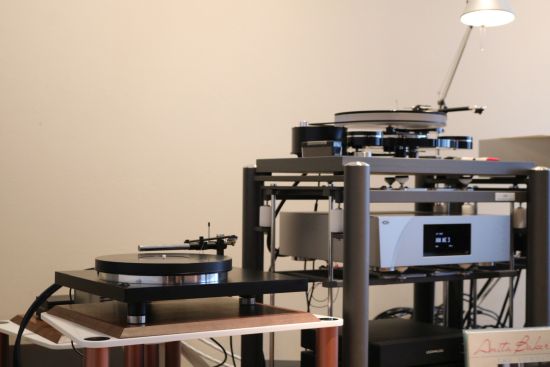
In order to achieve this level of performance, it is very important the cartridge is set up correctly. But that is the case with every turntable. Fortunately, the Holbo makes it very easy to get everything sorted. Unlike regular pivot arms, linear tracking arms are designed to have zero tracking error and this value does not change depending on the position on the LP. This means that all one needs to take care of is that the arm guide is set to a precise 90-degree angle and the cartridge is mounted in a straight fashion. Then, the overhang is adjusted by means of a supplied protractor with only a single line. When the needle tip is right on the line across the LP’s surface, then everything is peachy. All that remains is the tracking force which is easily adjusted with the counterweight and the VTA, the vertical tracking angle. This is where the Holbo again surprised me by offering VTA adjustment via a thumb wheel that, if you like, can even be used while the turntable is playing! With the Holbo, there is just none of the fiddly stuff that one might fear for when thinking of a linear tracking turntable.
All this talk of perfection may make one think that the Holbo sounds overly technical or, perhaps, non-emotional. Although it has no detectable character of its own, this is most definitely not the case. The Holbo is very neutral and clean itself but it can sound clean or voluptuous, cool or warm, flat or room-filling and anywhere in between, depending on the record, cartridge, cable, phono preamp and the rest of the system.
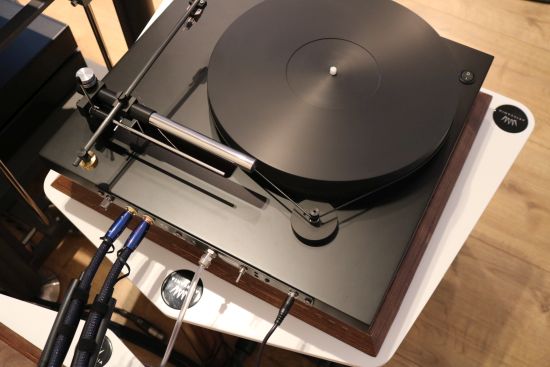
Cables
One choice that is left to the owner is in the interlink that is used between the Holbo and the phono preamp. I started with the AudioQuest Water which immediately revealed the turntable’s strong points as I mentioned above. This AudioQuest cable has a well-controlled and strongly delineated sound but it is not exactly lush and it can lack some subtlety and air. And in comparison with the Origin Live turntable with its lush-sounding Silvery Hybrid cable, I felt that the Holbo, while all-around great, was just a little bit flat and overly controlled in terms of front-to-aft soundstage movement.
Raiding my cable drawers to find alternatives with a different sound I found the “VLS high-grade audio cable”. This is a very cost-effective cable that does not look like much but it sounds very smooth and fluid and while it is a little soft it avoids sounding clogged. One may think it heresy to use this cable with such a fine system but I know that, above all, obtaining good results in audio is about synergy. And, clearly, this cable worked very synergistically with the Holbo and the Acoustical Systems cartridges.
With the AudioQuest’s stridency replaced with a sweeter rendition, the previously slightly rigid soundstage became more fluid and more engulfing indeed. Meanwhile, the Holbo’s supremely good speed and definition were largely unharmed.
The next cable that I tried was the Vermouth Reference which has a similarly controlled delivery as the AudioQuest but brings a more colorful sound along with more forceful bass which was working very well with the Holbo.
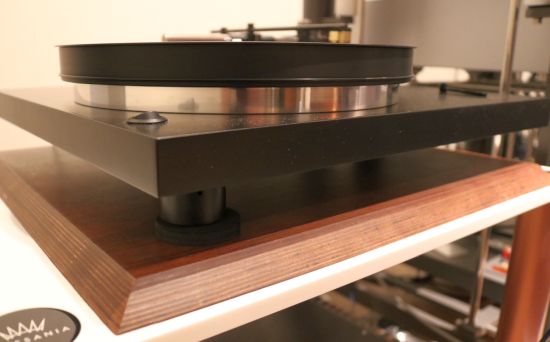
Feet
Thanks to its air bearings, the Holbo is said to be immune to influences from the material onto which it is placed. These same air bearings make that the turntable can be made from a single slab and with no suspension anywhere because those cushions of air inside the bearings are all the isolation that it needs. Given that I found no differences with the Holbo set up on the MDF shelf atop the Artesania Exoteryc rack’s outer frame or on the Artesania Modular Rack, there seems to be truth in the immunity statement.
The turntable’s integral feet contain spikes but no bases are supplied and so, Francois of Colab delivered 3 nicely matching stainless steel spike bases with the turntable. To test the influence of the feet I replaced the stainless steel bases and replaced them with Neoprene pads as supplied with Artesania racks.
As it turned out, this made a very noticeable difference. The steel bases make for the tightest and most articulate bass while the Neoprene pads provide a fuller and fatter bass with a thicker and more relaxed lower midrange which helps reduce the sense of leanness when the turntable is used with a lean-sounding cartridge. With the Acoustical Systems, I’d say that the stainless steel bases are perfect but it is good to know that different materials do lead to audible differences.
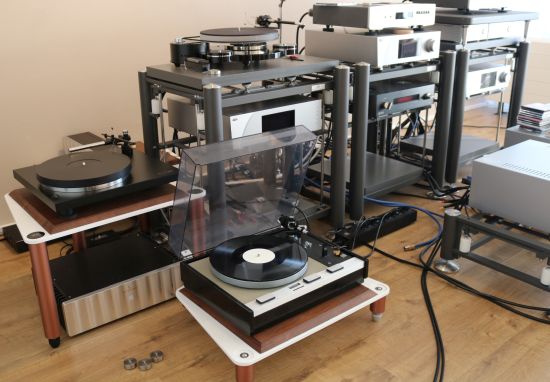
Comparisons
In order to more completely map the Holbo’s performance let me compare it to the Origin Live Calypso mk4 turntable. Compared directly, under identical circumstances, the Origin Live and the Holbo turntables have different presentations even if they both achieve a well-paced, neutral and revealing sound. The differences are predominantly in the character of the bass and in the soundstaging. While the turntables both appear to be very neutral when judged on their own, in direct comparison, the Origin Live has a bigger, fuller and more euphonic sound. This is mostly due to its more forceful bass and warmer midrange but also because this turntable throws its soundstage further back and creates 3D images that seem to possess more body than with the Holbo/Aiwon. The latter has a relatively flatter soundstage but the Holbo counters with even more precision in terms of lateral imaging. And while the Origin Live may have more forceful bass (which I personally like), this is shown as a deviation from neutral by the Holbo. The thing is, no matter how much I like the extra “boogie factor” of the Origin Live/Aidas combo, especially in terms of bass performance, the Holbo/Aiwon combo actually retrieves more detail and nuances in the bass and is ultimately more accurate.
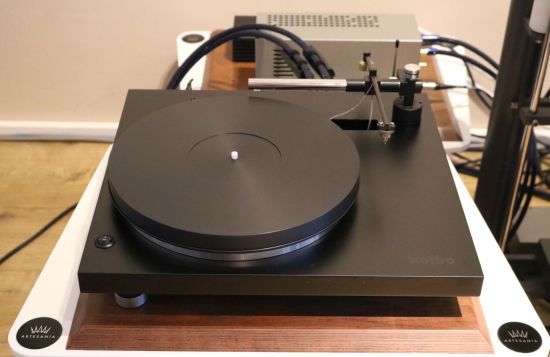
At this point, I have compared two complete turntable + cartridge systems which means that we cannot separate the turntable performance from that of the cartridges. On the other hand, we are comparing two carefully selected systems that are priced in the same ballpark. Regardless, the benefits of either turntable are already becoming quite clear.
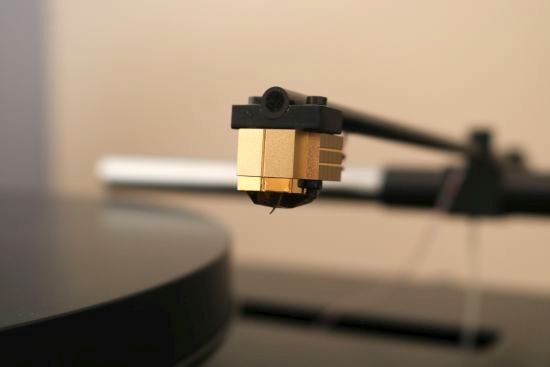
One cartridge of which I have two available is the Denon DL304. This humble cartridge is no longer available but it offered extremely good value for money at the time. Today, two of my friends still use it in their Thorens turntables where it has proved to be a very synergistic match. In order to get more grip on the Holbo itself without any influences from the Acoustical Systems cartridges, my friends were happy to make their Denons available for this test. Both cartridges have very few hours on them, they have already been compared before and they sound identical. I fitted one in a well-serviced Thorens TD125 mkII and one in the Holbo and made comparisons using a variety of records.
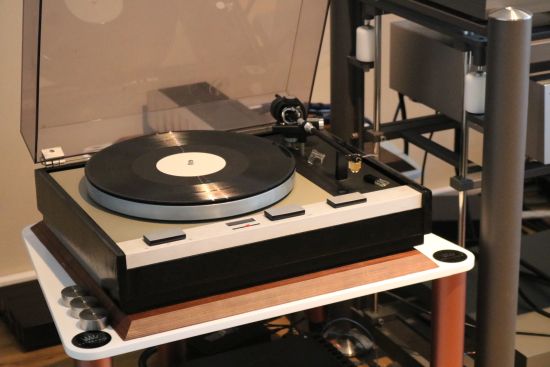
This comparison yielded two important results, one of which does not pertain strictly to the Holbo but I’ll save that one for last. First off, it became clear that the Holbo has significantly better tracking than the Thorens. The treble and upper midrange are much better behaved, airier and subtler than with the Thorens which is comparatively raw and unruly. Importantly, this happens no matter where the track is on the record, meaning that this is not tracking-error related but rather the result of the entire Holbo air-bearing’s precision and overall turntable architecture being more refined. The Holbo has impeccable timbre, this was already witnessed with the Aiwon cartridge but it is again confirmed with the DL304 which can sound a little bit synthetic compared to better cartridges but not here. Further, the midrange with the Holbo was much more ordered, individual sounds being clearer and less shouty as well as more distinctly inhibiting their individual places within the soundstage. The latter was not larger or deeper than with the Thorens but it was much more precise. Herein is also the potential for finding the sound to be comparatively a little restrained or less “festive” than with the comparatively jumpier, wilder and looser Thorens. It’s clear that the Holbo provides a more accurate portrayal of what’s on the record but with the Denon cartridge, it can appear comparatively a little matter-of-fact and is just not quite as soulful. At this point, it was made clear once again that the turntable-cartridge combination is of great importance.
The source of the DL304 sounding less “outgoing” in the Holbo lies predominantly in the performance of the bass. As I have heard before with a friend’s turntable when he switched from a pivot arm to an air bearing arm, pretty much all the audiophile parameters improved including the bass precision. The body of the bass, however, diminished considerably. At that point, only the fattest sounding records sounded satisfactorily full.
With this past experience in mind, I expected the Holbo to also sound thin but as I already mentioned, this was absolutely not the case with the Acoustical Systems Aiwon cartridge. As it now turns out, the Holbo does indeed not sound particularly fulsome in the bass itself but with the right choice of cartridge, this can be balanced out entirely. The Denon DL304 is already a little thin-sounding itself and when combined with the air-bearing arm that does not add any body itself, this threw off the balance just a little too much. As with all things in life, it’s all about balance, people.
The important message here is that a cartridge can make or break a turntable’s performance. Although I respect the Holbo with the DL304 and was already mightly impressed with the Holbo + Aiwon combination, there was still the Acoustical Systems Palladian cartridge to try. And as it would turn out, this cartridge is an absolute game-changer!
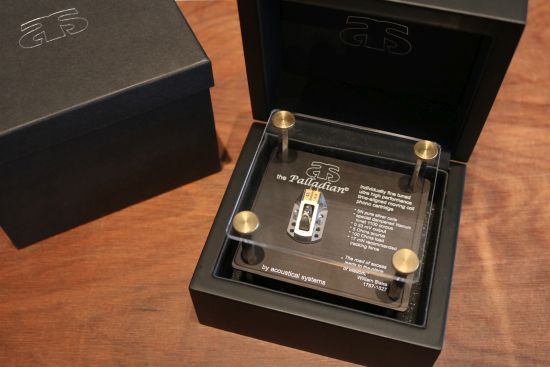
Acoustical Systems Palladian
The Palladian is visually very similar to the Aiwon which raises the question of what factors amount to the 2000-Euro price difference. Currently, the Acoustical Systems website does not offer much in the way of technical details and it is not immediately clear what differentiates the two. On a reseller’s site, I found a couple of technical specs but the differences are far from evident. The manufacturer’s website does contain a nice story of how the Palladian was conceived, the headlines of which can be read below.
When we introduced the Aiwon in early winter 2014 we were amazed by its subtle detail, by its ability to recreate tiny, tantalizing details – minor details that so immensely support the emotional impact and the sense of reality in a sonic picture. Over the next 18 months, we experimented with a few samples of the Aiwon trying to further fine-tune for even more impact in performance. But it was not before we made subtle changes in some key inherent design parameters that we entered new ground. This was the birth of the design which then evolved in the spring of 2016 into the palladian.
In the palladian we find a strong heart with more coil windings, a body more agile with less inertia (by means of reduced moving mass), further featuring a subtle mix of small measures taken to fine-tune each and every parameter of the performance allowing for a sonic explosion beyond our expectations and hopes.
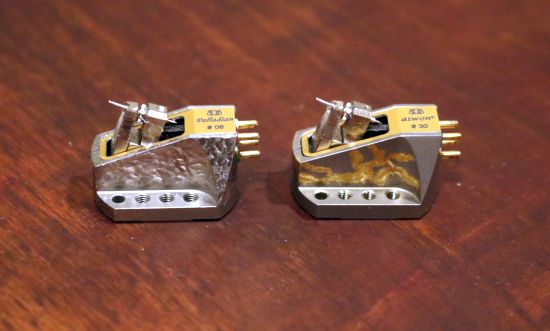
Acoustical Systems’ company motto is to reproduce live music to the best of their ability and that is something I think I can definitely relate to but still, this did not really tell me much. Apparently, the Palladian has one more winding in each of its 4 coils but is it otherwise identical? Upon contacting Pierre Costers at Colab, Dietrich Brakemeier of Acoustical Systems responded that the Aiwon and the Palladian do indeed share the same stylus (a Shibata version) and the C-37 treated AW7075 aluminum-alloy cantilever. However, the magnet and its extremely focused and orientated field in the Palladian is a novelty.
The tracking force is specified but in mN, not in grams. Just why the manufacturer would opt for this while everyone else uses grams, I don’t know, but an online conversion tool was found very quickly. As it turns out, 17mN equals 1.73 grams.
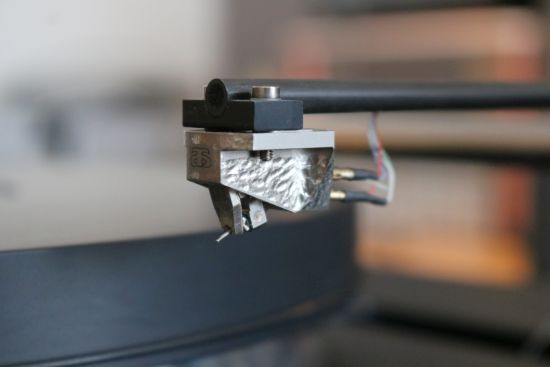
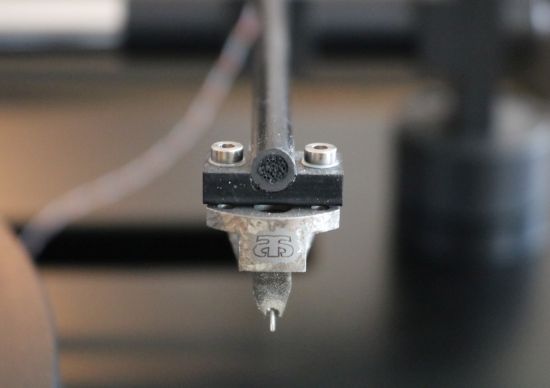
Listening with the Palladian
As the adjustable parameters for the two Acoustical Systems cartridges are identical and they both have pre-drilled threads and therefore require no fiddling with little nuts, the swapping was done in under 15 minutes. For this occasion, two friends were visiting and within seconds after the swap, we all agreed that this was something else! The switch from Aiwon to Palladian was not subtle!
All the aforementioned qualities of the Aiwon were present undiminished but now the sound was more solid, freer, more organic and considerably more spacious. The Origin Live was still more full-bodied and more euphonic, but the listening panel quickly agreed that these are taste-related matters and that the Holbo was simply performing absolutely fabulously. With the Palladian cartridge, the Holbo’s already highly refined delivery had become even more precise, with airier and even more refined treble and center images now being focused even more precisely both laterally as well as in the depth plane.
To be clear: the Holbo+Palladian is not only technically superb, this combo also fully relays the essence of the music. It has all the foot-tapping engagement and incurs heaps of emotional involvement and even with so-so recorded LP’s, the combo still sounds engaging.
Yes, you can safely say that we were in awe of the Holbo’s performance.
The Holbo is not inherently euphonic or romantic and neither are the Aiwon and Palladian cartridges. But they absolutely do not inhibit euphony. If it is on the record then it pours out of the system with no holds barred.
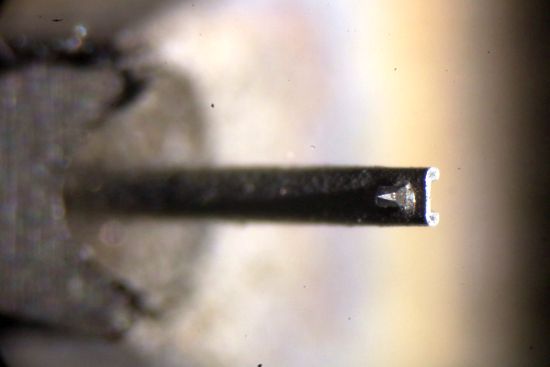
Extremely close-up photo of the Acoustical Systems Palladian cartridge’s cantilever and stylus made using a microscope. Here, you can very clearly see the complex shape of the Shibata stylus.
Stylus shape
One thing that I did notice is that while both the Aiwon and the Palladian produce faster and more accurate bass and especially the Palladian also sounds more fluid and airy and even more precise in the treble with the Holbo turntable than the ViRa Aidas Rainbow does with the Origin Live turntable, when playing slightly worn records, the Rainbow’s Fine Line needle tip does produce cleaner, less sibilant treble. That is not a matter of quality but it is something to consider when you buy a lot of second-hand vinyl. The thing to keep in mind is that Shibata styluses (as used for the Acoustical Systems cartridges) are said to combine high precision with full bass and if my limited experience is anything to go by, I can confirm that indeed fine line styluses tend to sound more slender in the bass. Thus, a fine line cartridge might retrieve a cleaner signal from worn records but it may not balance quite as well with the Holbo as the Acoustical Systems cartridges do. But I have only heard s limited selection of cartridges and there are many more variables that make the match successful or not. This is where having a knowledgeable dealer comes in very handily.
Conclusion
The Holbo Airbearing turntable may look simple but it has actually been very thoughtfully designed with ultimate transparency and neutrality as well as ease of use in mind. The Holbo can sound clean or voluptuous, cool or warm, flat or room-filling and anywhere in between, depending on the cartridge, cable, phono preamp and the rest of the system. It is so very neutral and even-handed and possessing of such incredible refinement and resolution that it is worth pairing with the best cartridges out there.
The Holbo is not inherently euphonic or romantic and neither are the Aiwon and Palladian cartridges. But they absolutely do not inhibit euphony. If it is on the record then it pours out of the system with no holds barred. Especially when fitted with the Acoustical Systems Palladian, it does not only reproduce all the technical facets of the recordings in all their splendor, it also conveys the musical message itself in a completely involving manner.
There is no beating around the bush: the Holbo air-bearing turntable offers a reference-level performance that will be hard to beat. The first contender that springs to mind is TechDAS and even this brand’s most affordable turntables are considerably more expensive than the Holbo, and they don’t come with a tonearm. Did I mention that the Holbo turntable complete with tangential arm costs only 6500 euros?
Specifications
Acoustical Systems Aiwon MC Cartridge
High Purity 5N Silver Coils
Special dampened timet 1100 titanium alloy corpus
0.28 mV output
4 Ohms Internal resistance
100 Ohms load
17 mN recommended tracking force (1.73 grams)
Q4 Shibata EVO stylus
C37-coated tempered aluminum Cantilever
Static compliance 16-18 mm/N (18°C to 30°C)
Channel balance better than 0.35 dB / at 1 kHz
Channel separation better than 32 dB
Frequency response 15 Hz to 32 kHz +/- 2 dB
Cartridge weight: 11.5 grams
Acoustical Systems Palladian MC Cartridge
High Purity 5N Silver Coils
Special dampened timet 1100 titanium alloy corpus
0.33 mV output
5 Ohms Internal resistance
100 Ohms load
17mN recommended tracking force (1.73 grams)
Q4 Shibata EVO stylus
C37-coated tempered aluminum Cantilever
External Links
Manufacturer: Acoustical Systems and Holbo
Holbo Distributor for the Benelux: Colab
Acoustical Systems Distributor for Belgium: Colab
